Check-ins Done Right: How to Get the Most Out of Check-Ins
Let's find out how to get the most out of check-ins, and how to create a check-in culture.
Regular check-ins are the foundation of a continuous feedback culture and positive employee experience, and since the shift to remote working many companies are implementing a structured approach to check-ins. It is more important than ever to have continuous conversations with employees about their performance, so in this week's webcast we take a deep dive into employee/manager check-ins, exploring how to create a check-in culture. We cover the benefits of check-ins, the different check-in types, and recommend our best practices to help you establish a check-in culture.
Watch the full webcast here:
Embedded content: https://www.youtube.com/embed/40Orm61wwBs
What are check-ins?
Simply put, check-ins are regular employee/manager meetings that cover a wide range of topics, from progress, goals and personal development to employee well-being. In the past few years, there has been a shift away from annual appraisals to a continuous feedback model, which revolves around regular check-ins between employees and managers. Coupled with this, there is demand from employees for more real-time feedback on performance, especially from younger generations. With Generation Z set to enter the workforce in the next few years, it is increasingly important to cater to their needs.
When regular check-ins are implemented correctly, they set the foundation for positive employee-manager relations, and drive both performance and engagement. The fact is employees need regular check-ins more than ever before, as they establish a dialogue and create an environment that is most conducive to positive working relationships.
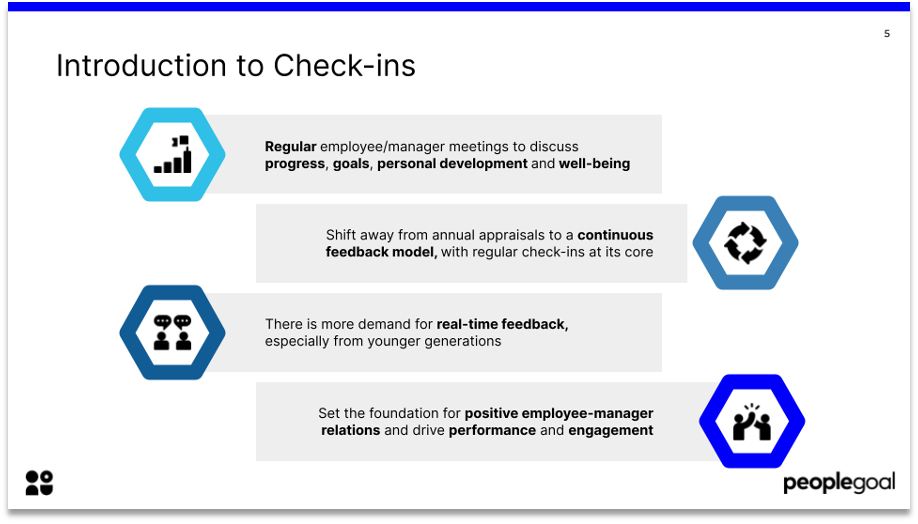
Why are check-ins important?
- Establish a clear channel of communication
- Continuous feedback improves progress
- Solve problems before they escalate
- Build trust between employees and managers
- Boost motivation through involvement and productivity
There are many benefits associated with running regular check-ins. First of all, check-ins establish a clear channel of communication between managers and their direct reports. They allow employees to receive frequent feedback on work related items, as well as stay in the loop with the organization in general. Regular 1-1 meetings will encourage managers to give timely feedback to their direct reports, driving the organization towards a continuous feedback model. Moreover, frequent discussions about areas that need improvement will provide the ideal opportunity to identify problem areas and act before they escalate.
Check-ins not only provide an opportunity to exchange information, but also help foster an interpersonal bond between team members, effectively building trust through the reporting line. Finally, having the ability to communicate with a manager on a frequent basis will motivate employees to do their best work, as well as establish a measure of productivity where the can track improvements between check-ins. Giving and receiving timely and relevant feedback is a vital part of the employee development process, and is a great way for a company to create an open and supportive organizational culture.
Frequent employee check-ins are the best way to overcome issues linked to engagement, as well as provide direction and promote continuous learning.
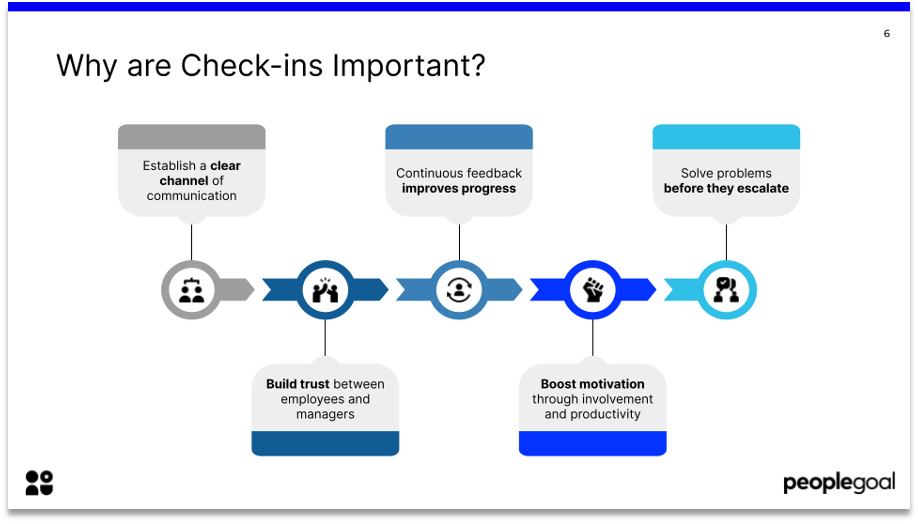
The Different Types of Check-in
Now we will review the different type of check-ins:
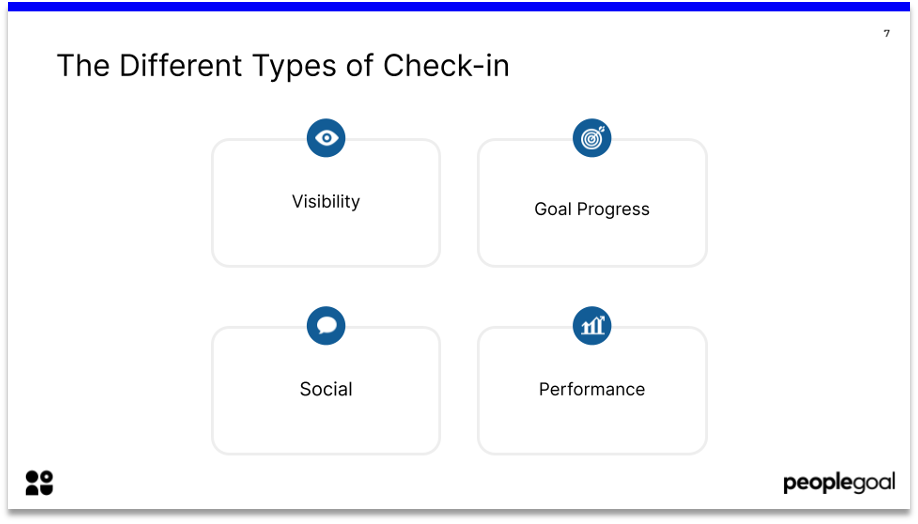
- Visibility
Give teams the opportunity to learn about things beyond the scope of their role and responsibilities. They will learn about the company's latest developments and therefore feel more connected to the organization.
- Goal progress
Track employee progress towards their performance and development goals. Are of high value as managers can track how employee goals are linked with the organization's overall strategic direction.
- Social
Help connect team members (especially remote workers) on a personal level. It is important to share personal news that is unrelated to work. Can also be used to monitor well-being.
- Performance
Review overall employee performance, give constructive feedback on what has gone well and which areas require improvement.
When it comes to check-ins, one size does not fit all, ensure you cover 2-3 touch points with employees throughout the year.
Practical Implications
Firstly, you need to consider how you are going structure your check-ins. Will you provide managers will a list of questions to ask, or some talking points/conversation starters? Or will you leave the discussion open to the manager and employee. In our experience, it is best to provide some form of structure to managers - especially if this is a new process - to ensure that check-in conversations are productive and useful.
Secondly, you should decide on the cadence of your check-ins. Will you run your check-ins daily, weekly, monthly or quarterly? This depends on the other processes you have in place, and how your check-ins will fit in within your wider performance management process. We recommend allowing employees and managers to catch up as frequently as possible, without overwhelming time-stretched employees. We suggest that 1-1 performance check-ins happen at least monthly, and can be tied in to a formal quarterly check-in and annual performance review. However, this entirely depends on your company culture, employee workload and employees' desire to participate in a continuous feedback system.
Thirdly, you need to think about whether you would like your check-ins to be formal or informal. Formal check-ins are scheduled, company-wide touch points that all employees and managers need to participate in, i.e. quarterly performance check-in. Informal check-ins are when an employee requests to meet with their manager on an ad-hoc to discuss their work. We suggest using a combination of both formal and informal check-ins, so to allow managers and employees to catch up about specific needs and projects whilst also having a structured performance conversations.
Check-ins should be in line with the company culture, and what the company wants to achieve
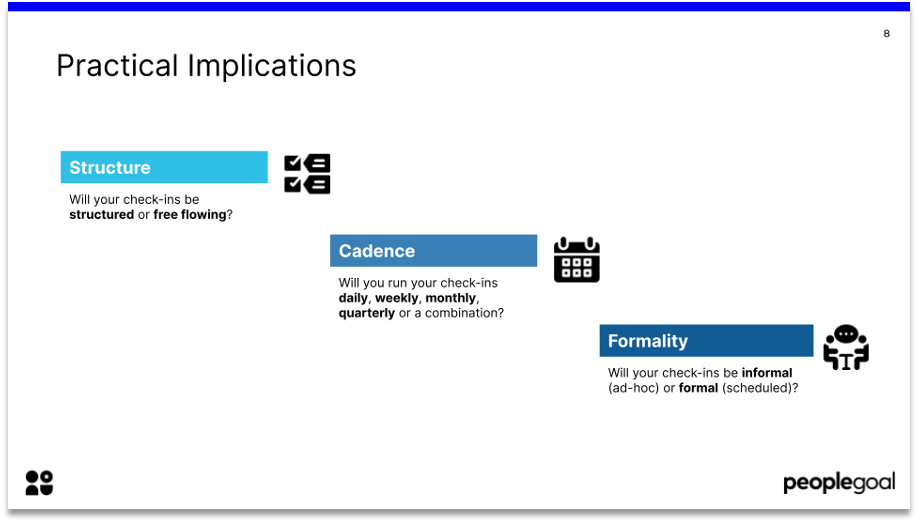
Check-in Question Examples
Here are some example questions, taken from our check-ins app template:
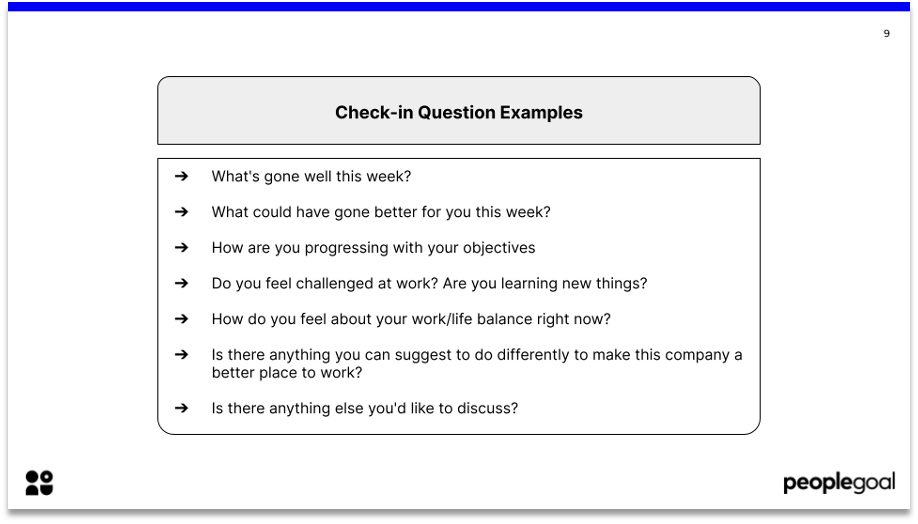
- What's gone well this week?
- What could have gone better for you this week?
- How are you progressing with your objectives
- Do you feel challenged at work? Are you learning new things?
- How do you feel about your work/life balance right now?
- Is there anything you can suggest to do differently to make this company a better place to work?
- Is there anything else you'd like to discuss?
Learn how to have an Employee Manager Check-In with PeopleGoal here
How to Create a Check-in Culture: 5 Best Practices
Follow these 5 best practices to establish a check-in culture. From an HR perspective this is a simple process, which will bring a lot of value to the overall employee experience.
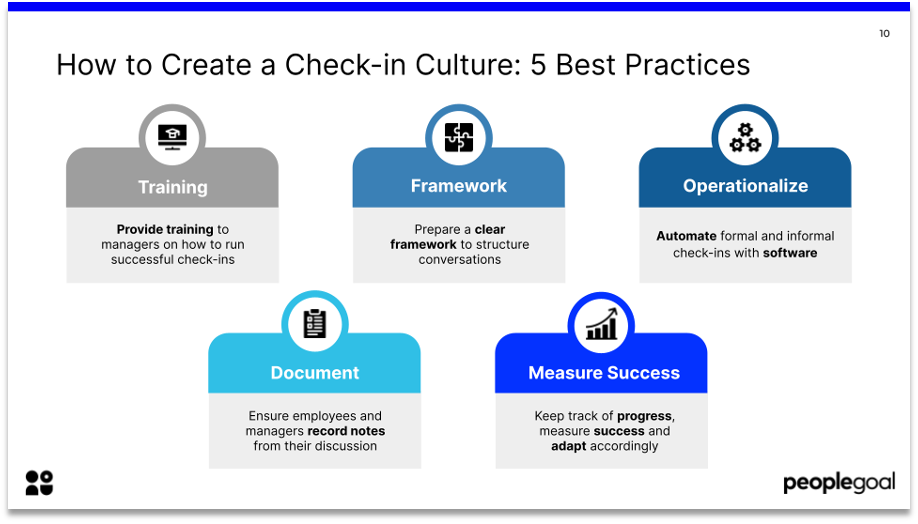
1. Training
We cannot understate the importance of providing training to manager on how to run successful check-ins. It is important to dedicating time to training managers on both the importance of regular conversations, as well as how to go about them, the check-in process may not be a success.
2. Framework
Prepare and provide to all managers a clear framework to follow during check-in conversations, to help structure conversations. This will help guide conversations and ensure they are as productive as possible.
3. Operationalize
We advise that you automate your formal check-ins with software. Look for a software that will also allow employees and managers to request an ad-hoc check-in with their counterpart.
4. Document
Ensure that somebody in the meeting records the notes from the discussion, so there is a clear record of what has been said. This is very useful for managers when they are compiling feedback from throughout the year for the performance appraisals.
5. Measure success
Once you've launched your check-in initiative it is a good idea to keep track of progress. Are employees engaging with the process? How many check-ins are completed every month? Are there any departments who aren't completing their check-ins, and why? And then if there are any issues, adapt accordingly. Monitor the process continually, take note of the sucesses and any gaps and make the necessary changes.
Key Takeaways
Regular check-ins encourage better performance, engagement and retention
Leverage both formal and informal check-ins
Provide training and a clear framework to managers to ensure success
Follow our best practices to establish a check-in culture to see the best results
Want to learn more?
Enjoyed learning about check-ins? Check out the full webcast here. If you are considering implementing a new check-ins initiative, have a take a look at our article Employee Manager One on One Meeting: A Guide.
Need some help kicking off with your check-ins process using our fully customizable platform? Book a demo with PeopleGoal today!
Catch up with our previous webcasts below:
